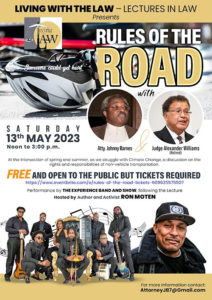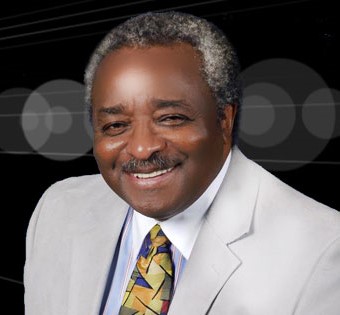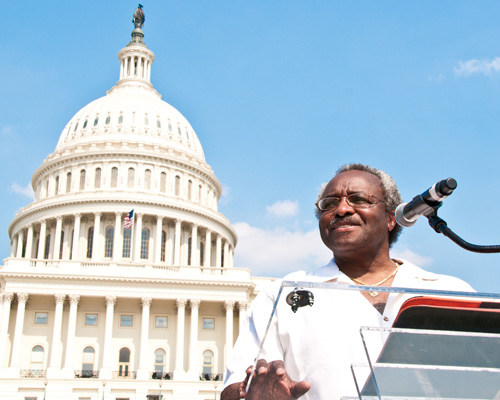A LEGAL ARTICLE FROM THE RULES OF THE ROAD TOWN HALL MEETING
What Pedestrians and Cyclists Need to Know About Contributory Negligence in the DMV
by Bradley A. Thomas © 2023
 It’s no secret that the government of the District of Columbia, under the leadership of current threeterm Mayor Muriel Bowser, has been pursuing policies to make the Nation’s Capital a more pedestrian and bicyclist friendly jurisdiction. There are many good reasons for that policy. Reducing the number of motor vehicles on the District’s street is more likely than not to produce a corresponding reduction in traffic injuries and deaths. Fewer cars on the street will eventually result in shorter commute times for those who do rely on motor vehicles to go about their daily routines, especially during D.C.’s notorious “rush hour.” (I place the term rush hour in quotes because anyone who has ever driven on the city’s streets during the morning or the late afternoon hours knows that the time period is more like three or four hours during which no one rushes anywhere.) Finally, the more people opt not to operate gasoline burning vehicles, the less our region will be impacted by the harmful effects of greenhouse gasses and air pollution. As an environmentalist1, I can certainly relate to that last potential benefit.
It’s no secret that the government of the District of Columbia, under the leadership of current threeterm Mayor Muriel Bowser, has been pursuing policies to make the Nation’s Capital a more pedestrian and bicyclist friendly jurisdiction. There are many good reasons for that policy. Reducing the number of motor vehicles on the District’s street is more likely than not to produce a corresponding reduction in traffic injuries and deaths. Fewer cars on the street will eventually result in shorter commute times for those who do rely on motor vehicles to go about their daily routines, especially during D.C.’s notorious “rush hour.” (I place the term rush hour in quotes because anyone who has ever driven on the city’s streets during the morning or the late afternoon hours knows that the time period is more like three or four hours during which no one rushes anywhere.) Finally, the more people opt not to operate gasoline burning vehicles, the less our region will be impacted by the harmful effects of greenhouse gasses and air pollution. As an environmentalist1, I can certainly relate to that last potential benefit.
The downside to the push toward walk ability and bike ability, and the resultant increase in walkers, cyclists and scooter-riders, is that there are more incidents of careless behavior by non-motorists on our streets. In increasing numbers, pedestrians, scooter-riders and cyclists are choosing to ignore stop signs, don’t walk signals and red lights. Walkers, often distracted by their mobile devices, step off the curb, sometimes in the cross-walk and sometimes not, without even bothering to look for oncoming traffic. Bikers and scooter-riders blow through stop signs and red lights without slowing down and with barely a glance to the right or left. In so doing, they often pass through intersections dangerously close to motorists who actually have the right of way. What’s worse, is that in many if not most of those near-miss situations, the careless non-motorists seem to exhibit the attitude that the motorists, and not they themselves, are at fault in these close encounters. For some, this misguided attitude stems from a self-centered sense of entitlement and egocentricity. I’m right, you’re wrong, end of discussion. But for many, I suspect, the root of the problem is a misunderstanding of the law with regard to negligence liability.
Negligence is one of three categories of tort law, the other two being intentional torts and strict liability. Loosely defined, a tort is a civil wrong for which the law provides a remedy.2 In other words, it’s the body of law that says if someone does harm to you, you have a personal right, outside of whether the act against you is in violation of some criminal law, to seek some form of compensation or redress against the wrongdoer. An example of an intentional tort is battery where, for example, someone punches you in the face without provocation. Strict liability deals with injuries caused by items, exotic animals or practices and procedures which are dangerous by their very nature. If you choose to avail yourself of such things, you may be strictly liable for any injuries caused to other people. Negligence, however, is the body of law that provides for remedies for persons who are injured by the behavior of others which is accidental or unintentional in nature. Some of the most common examples of negligence cases are those which arise out of motor vehicle accidents. You can’t watch an hour of television, especially in the daytime, without seeing one or more commercials that start with “if you’re been injured in a car or truck accident due to somebody else’s negligence, you need a good lawyer!”
Now to recover on any negligence claim, an accident victim has to prove four elements; duty, breach, damages and causation. First, the victim (or the person standing in the shoes of the victim if the victim is deceased or rendered incapable to represent himself) must establish that the at-fault party owed a duty to the victim which, in the typical accident case, is the duty to act with reasonable care under the circumstances. That means that when operating a motor vehicle, drivers have a duty to obey speed limits, stop at stop lights, signal upcoming turns, make safe lane changes and stay alert to avoid endangering others who may be sharing the roadway in vehicles or on foot. Second, the victim must show that the at-fault party committed a breach of that duty by failing to follow traffic regulations or drive in a safe and prudent manner. Third, the victim must prove that he or she suffered some damages. Those damages could be anything from a dented bumper to serious bodily injury or even death. Fourth, it must be established that the damages suffered by the victim were caused by or, that is, directly arose out of the misconduct of the at-fault party. If the accident victim is able to prove all four elements, he or she is entitled to receive monetary compensation from the at-fault party or, more commonly, from the insurance company which insures the at-fault party. Many pedestrians, scooter-riders and cyclists seen to act out of some sense of invulnerability arising out of the belief that no automobile operators will dare strike them and, if a collision does occur, they, the non-drivers, will be handsomely compensated for their losses and injuries. If you, a reader of this article, are of that mindset, let me share with you two words that should usher in a dose of reality; contributory negligence.
Contributory negligence is a term which refers to the degree to which the negligence of the accident victim contributed to occurrence of the accident itself. It’s similar to but legally distinguishable from another two word term, comparative negligence. When it comes to injury cases, every jurisdiction including the District of Columbia follows some form of either a contributory negligence or a comparative negligence model. In general, in states which follow a comparative negligence model, liability (or legal responsibility) for the damages sustained by an accident victim is proportioned between the person claiming to have been injured and the person alleged to have caused the injury. By way of a simple example, if plaintiff (the party bringing the lawsuit ) in an automobile accident case has incurred medical bills of $6,000.00 plus $4,000.00 in lost time from work, and has experienced pain and suffering from the accident which a judge or jury determines is valued at another $10,000.00, the total damages of that victim are $20,000.00. But if that same judge or jury finds that the defendant (the party being sued) was only 75% responsible for the accident while the victim was actually 25% responsible, the damages awarded to the plaintiff will be only $15,000.00, 75% of the $20,000.00 total damages. On the other hand, in contributory negligence jurisdictions, a plaintiff who is found to have contributed to even the smallest degree is barred from any recovery. Thus, in the previous example, if the same accident occurred in a contributory negligence state and the plaintiff was only 1% negligent while the defendant was 99% at fault, the plaintiff with the same $20,000.00 in damages will recover absolutely nothing.
Comparative negligence is clearly the fairer and more enlightened view and more and more states across the country have made the shift to it from the old contributory negligence model. In fact, to date, 46 states subscribe to one form or another of the comparative negligence model. Unfortunately, for accident victims in the DMV, the five jurisdictions which still apply the rule of contributory negligence are Alabama, North Carolina, Maryland, Virginia and the District of Columbia. That means that if you are a pedestrian, cyclist or scooter-rider anywhere in the Washington, DC metropolitan area, and you are involved in an accident with a motorist, your own acts or omissions could potentially bar your recovery in a lawsuit against the negligent driver.
Let me pause here to qualify that last statement by pointing out that there are some exceptions to the no-recovery rule in D.C., in Maryland and in the Commonwealth of Virginia. To begin with, all three jurisdictions recognize the “last clear chance” doctrine. Under last clear chance, even if the accident victim, the plaintiff, acted in a way that contributed to his or her injuries, the plaintiff’s contributory negligence will not bar any and all recovery if the other party had the last clear chance to avoid the accident but didn’t take appropriate action to do so. An example might be that a pedestrian steps off the curb against a red light or don’t walk signal and a speeding driver sees her, has time to stop, but instead of slowing down, plows straight through merely because his light is green, striking the pedestrian in the crosswalk. In that example, the driver was primarily negligent because he was speeding. The pedestrian was contributorily negligent because she stepped off the curb against the light however the pedestrian’s contributory negligence will not bar her recovery of damages because the driver had the last clear chance to avoid the accident and didn’t. But let’s change one element in this scenario. Let’s say that there was a Metrobus stopped at a bus stop near the intersection so that the driver could not see the pedestrian step off the curb. The collision with the pedestrian then occurred just as the driver passed the bus who didn’t see the pedestrian until the instant before he struck her. In that case, since the driver did not have the last clear chance to avoid the accident, the pedestrian, who may have suffered catastrophic injuries, may be barred by her own contributory negligence from recovering a dime, even though the driver was in fact speeding.
There are other exceptions. Virginia recognizes that as a matter of public policy, persons injured by drivers engaged in willful or wanton conduct, like drunk driving, should not be barred from recovery because of their own contributory negligence. Going back to that last example, if the speeding driver was also severely impaired under the influence of alcohol, the jay-walking pedestrian will not be barred from recovery, regardless of the last clear chance perspective of the driver. Also in Virginia, a passenger on a common carrier, a bus, train, taxi or ride share vehicle, is not barred from recovery of damages from a negligent motorist due to the contributory negligence of the passenger. Think, for instance, of a passenger standing on a bus but not holding onto a safety pole who is thrown to the floor of the bus when the bus is struck by a car. The passenger’s failure to hold on, though it could be considered negligence and a contributing factor in the passenger’s injury, will not bar the passenger’s recovery of damages. In Maryland, the contributory negligence of a child 5 years of age or younger will not bar that child or his parents or guardians from recovering damages for the child’s injuries. And similar to the rule in Virginia, the contributory negligence of a pedestrian, cyclist or scooter-rider in Maryland will not bar her recovery of damages caused by the intentional acts of a driver. A driver who is motivated by road rage to strike a cyclist will not escape liability in Maryland based on the cyclist’s contributory negligence. Additionally, a court is likely to find that the act of a driver striking a pedestrian after becoming voluntarily intoxicated falls under the “intentional acts” exception such that the contributory negligence of the pedestrian will not be a bar to his recovery.
In the District of Columbia, there is actually a statute that lays out exceptions to the general contributory negligence rule for pedestrians and “vulnerable users” of the city’s roadways.3 Under D.C. Law 23-183, if the plaintiff (the injured party) was a pedestrian or a vulnerable user of a public highway or sidewalk, the plaintiff’s contributory negligence will not be an absolute bar to recovery in a lawsuit unless the plaintiff was more than 50% responsible for the occurrence of the accident. The statute defines vulnerable user as “an individual using an all-terrain vehicle, bicycle, dirt bike, electric mobility device, motorcycle, motorized bicycle, motor-driven cycle, non-motorized scooter, personal mobility device, skateboard, or other similar device.”4 That law, from the perspective of injured pedestrians, cyclists and scooter-riders, effectively converts the District of Columbia from a pure contributory negligence jurisdiction to more of a comparative negligence jurisdiction. Thus, going back to our pedestrian-stepping-off-the-curb-against-the-light-while-the-driver’s-view-isobscured- by-a-bus example, if you are the pedestrian, it will be on you to prove that the accident was not more attributable to you than to the driver. In other words, you will have to prove that 1) the driver was negligent by speeding and/or not paying full time and attention to his driving and 2) that the driver’s dereliction of duty was at least as responsible, if not more so, than your own negligence in causing the accident to occur. That could be a heavy lift.
The best advice I can give to pedestrians, bikers and scooter-drivers, especially those in the DMV, is to be careful, act prudently and adhere, as closely as you can to the rules of the road. Becoming an accident victim can be a painful and unpleasant experience at its best. At its worse, it can leave you disabled or dead. No one I know would willingly trade a limb, much less a life, for any amount of monetary compensation. But if you live in the District, Maryland or Virginia (not to mention Alabama and North Carolina), the rules of contributory negligence could add insult to injury by denying you the right to legal redress because of your own carelessness. In the future, when you approach a red light or don’t walk signal, ask yourself this question: “Is the minute or two I might save by running this light worth the risk of being involved in a debilitating accident for which I might ultimately receive no compensation?” Ponder that question and then act accordingly.
__________________________
1 The author holds an ALM in Sustainability from Harvard University where he published a thesis on environmental justice in 2020.
2 This definition of the law of tort can be found in Prosser, Wade and Schwartz's Torts: Cases and Materials, 12th Edition.
3 D.C. Law 23-183, which is titled the Vulnerable User Collision Recovery Amendment Act of 2020, amended the Motor Vehicle Collision Recovery Act of 2016, effective November 26, 2016 (D.C. Law 21-167; D.C. Official Code § 50-2204.51 et seq.). The bill was adopted on first and second readings on Nov. 17, 2020, and Dec. 1, 2020, respectively. After mayoral review, it was assigned Act No. 23-537 on Dec. 22, 2020, and transmitted to Congress for its review. D.C. Law 23-183 became effective Mar. 16, 2021.
4 See D.C. Code §50–2204.51(13).

DISCLAIMER: The author of this article, Bradley A. Thomas, owner and principal attorney of the Law Offices of Bradley Ashton Thomas, is a licensed attorney in the District of Columbia, Maryland and Virginia, with more than four decades of experience in litigation, negotiation and settlement of personal injury cases, inside and outside of the DMV region. This article was written for general informational purposes only. It is not intended to provide legal advice in any individual circumstances and the reader’s consumption of this article and its contents does not create or establish any attorney-client relationship between the author.






